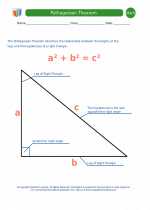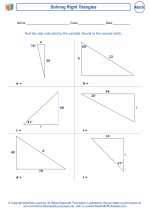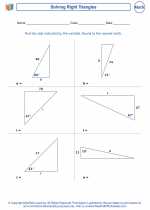The Pythagorean Theorem -> pythagorean theorem
Pythagorean Theorem
The Pythagorean Theorem is a fundamental principle in mathematics that relates to right-angled triangles. It provides a way to calculate the length of the sides of a right-angled triangle based on the lengths of the other two sides. The theorem is named after the ancient Greek mathematician Pythagoras, who is credited with its discovery.
The Theorem
The Pythagorean Theorem states that in a right-angled triangle, the square of the length of the hypotenuse (the side opposite the right angle) is equal to the sum of the squares of the lengths of the other two sides. Mathematically, it can be expressed as:
c2 = a2 + b2
Where c represents the length of the hypotenuse, and a and b represent the lengths of the other two sides.
Example
For example, if we have a right-angled triangle with sides of length 3 and 4, we can find the length of the hypotenuse using the Pythagorean Theorem:
c2 = 32 + 42
c2 = 9 + 16
c2 = 25
c = √25
c = 5
So, the length of the hypotenuse is 5 units.
Study Guide
To understand and work with the Pythagorean Theorem effectively, it's important to remember the following key points:
- Understand the concept of a right-angled triangle and the names of its different sides (hypotenuse, adjacent side, opposite side).
- Memorize the formula c2 = a2 + b2 and understand how to apply it to find the length of the hypotenuse or one of the other sides.
- Practice identifying right-angled triangles and applying the Pythagorean Theorem to solve for unknown side lengths.
- Understand the connection between the Pythagorean Theorem and the concept of distance in coordinate geometry. The theorem can be used to calculate the distance between two points in a coordinate plane.
- Be familiar with the converse of the Pythagorean Theorem, which states that if the square of the length of the longest side of a triangle is equal to the sum of the squares of the other two sides, then the triangle is a right-angled triangle.
By mastering the Pythagorean Theorem, you'll develop a solid foundation in geometry and be well-prepared to tackle more advanced mathematical concepts.
.◂Math Worksheets and Study Guides Seventh Grade. The Pythagorean Theorem

 Study Guide
Study Guide
 Worksheet/Answer key
Worksheet/Answer key
 Worksheet/Answer key
Worksheet/Answer key
 Worksheet/Answer key
Worksheet/Answer key
 Worksheet/Answer key
Worksheet/Answer key
 Worksheet/Answer key
Worksheet/Answer key
 Worksheet/Answer key
Worksheet/Answer key
 Worksheet/Answer key
Worksheet/Answer key
 Worksheet/Answer key
Worksheet/Answer key
 Worksheet/Answer key
Worksheet/Answer key
 Worksheet/Answer key
Worksheet/Answer key
